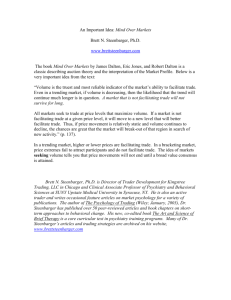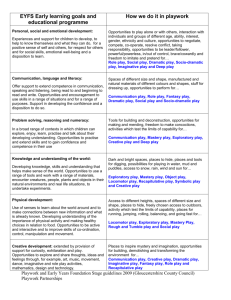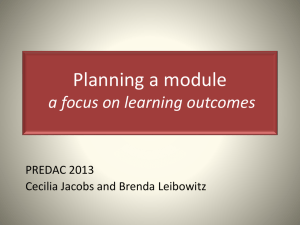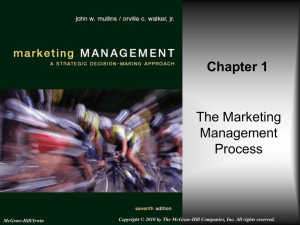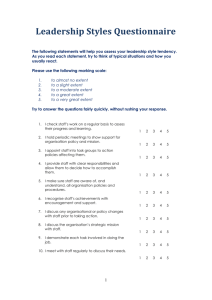Let the Children Play # 2 What and Why
advertisement
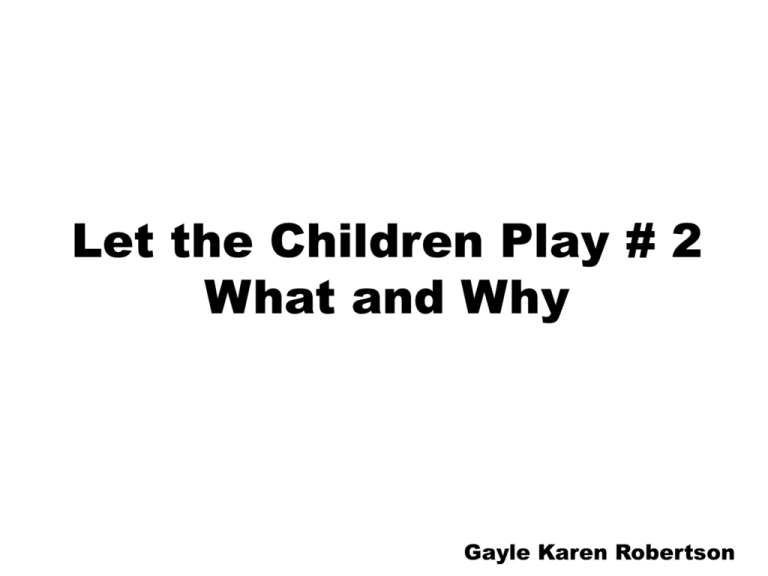
Let the Children Play # 2 What and Why Gayle Karen Robertson Play is the answer to the question, “How does anything new come about?” Learning allows us to acquire what is already known. Play gives rise to new knowledge, skills and artistic products. Viewed in this way, I believe play is vitally necessary in the world today, particularly in our schools. (David Elkind, 2007, The Power of Play) What has been said in the past about play? Philosophers and academics have been debating this for centuries. Here are some of their thoughts: Friedrich Froebel (founder of Kindergarten) argued that young children’s play was their primary way of learning about the real world. He devised a series of ‘gifts’ that were played with by children one at a time. Lev Vygotsky, psychologist, wrote extensively on cognitive development. He said that through play the child develops abstract meaning separate from the objects in the world. This is a critical feature in the development of higher mental functions. He argued that at the root of the “pretend play” situation is the tendency to realise desires that cannot be fulfilled in real activity, thus opening the way to imagination. Maria Montessori, founder of Montessori schools, believed that children learned about the world through their play with particular materials. She believed in a carefully prepared environment with materials to be explored independently which would lead to the discovery of particular concepts. Others have said that play is . . . “. . . how children learn what no one can teach them.” (Lawrence Frank) “. . .an absorbing activity in which healthy young children participate with enthusiasm and abandon.” (Scales et al 1991) “. . .an arrangement in which one can practice behaviour without dreading its consequences (Csikszentmihalyl 1981) “. . . a natural, spontaneous and voluntary activity in which all of us, children and adults, benefit from engaging in throughout our lives. (A Play Strategy for Scotland) “. . . behaviour which is freely chosen, personally directed and intrinsically motivated.” (PlayEd, Scotland, 1982, Wales 2000) “. . . not work. Not something you must do but something you choose to do. Play can be work if it is assigned. Work can be play if it is chosen. (Otto Weininger 1980) “. . . an activity which is positively valued by the player, self-motivated; freely chosen, engaging; “ (Garvey 1977) “. . . light, brisk or changing movement, to act or imitate the part of a person or character; to employ a piece of equipment; to exercise for amusement or recreation, fun or jest; the action of a game.” (Webster’s Dictionary) “. . .a biological, psychological and social necessity, fundamental to the healthy development and well being of individuals and communities (Play Wales 2005) Play provides a context through which the child develops representational thought which is an essential foundation for reading, mathematics, and science. (Vygotsky in J.S. Bruner , A. Jolly, & K. Sylva Play develops higher motivation to learn and higher self-esteem. (Weininger, 1994) Play is an integral part of a child’s being. It is the business of childhood and it has a unique and vital role in the whole education process. (Weininger, 1994) So now we know what it is, let’s look at why it is so important to the growth and development of our young children. The importance of play to children is strongly supported by researchers from a range of disciplines including psychology, education, philosophy, anthropology and recreation. International Play Association (Canada) Promoting the Child's Right to Play www.ipacanada.org/children.html Why Play? Psychologists Elena Bodrova and Laura Berk explain that play allows children to develop self-regulation of ‘executive functions’ which predict school success better than IQ. The self regulating language (or self-talk) often used in make-believe play helps children manage their emotions and master cognitive skills. Why Play? Play enhances a child’s language development. (Garvey 1974) Play encourages creativity and problemsolving. (Dansky, 1980) Why Play? Play is recognized as an important vehicle for developing all aspects of literacy because it provides a functional, meaningful setting for language development. (Manitoba ELA Curriculum Overview, 1998) Why Play? Free, imaginative play is crucial for normal social, emotional and cognitive development. It makes us better adjusted, smarter and less stressed. (Melinda Wenner, Scientific American, Jan 28, 2009) Why Play? “Unless we engage in symbolic, dramatic play, we don't develop a good sense of empathy with others. Play is crucial to understanding what it's like to be some other kind of person." Henderikus Stam, psychology professor at the University of Calgary. Why Play? Play is essential to developing social and emotional ties. There is evidence that play is linked to the development of strong parent-child relationships. (Ginsburg, K. R. (2007) Children’s healthy development is mediated by appropriate nurturing relationships with consistent caregivers. (Neurons to Neighbourhoods, 2000) Why Play? A report by the American Academy of Pediatrics (Ginsburg 2007) pleaded for the restoration of play to develop socialemotional skills such as building resilience, managing stress, and forming relationships with adults and peers within and outside the family. Why Play? A longitudinal study measured the complexity of children’s block play at age 4 and then tracked their academic performance through high school (Wolfgang, Stannard, & Jones, 2001). Researchers found that the complexity of block play predicted kids’ mathematics achievements in high school. Those who had used blocks in more sophisticated ways as preschoolers had better math grades and took more math courses (including honors’ courses) as teenagers. Why Play? Dramatic play is an effective way to learn and practice social skills. Children who become more engaged in dramatic play involving make-believe, verbal interaction and which is sustained for some time were found to have improved self-control. Why Play? Play is the way young children learn. The Canadian Association for Young Children (CAYC) has published two position statements supporting play for preschoolers and children in school. They can be accessed online at www.cayc.ca Why Play? The Association for Education International (ACEI) has published a position statement supporting play. It can be found at www.acei.org/playpaper.htm The National Association for Young Children (NAEYC) has published a number of papers promoting play. Their publication Developmentally Appropriate Practice supports play as the way young children learn. What activities are play to you? Get a piece of paper and a pencil. Draw a line down the middle of the page. On the left side write down 6 to 10 things you consider play for yourself. On the right hand side write down 6 to 10 things you consider play for children. Two Types of Play Free-unstructured play: - imaginative, creative, has no clearly defined rules or goals except as the child (or adult) chooses. Structured play: -goal-oriented and has been structured by someone or something - may foster academic and adult related skills, may involve electronic play activities, games with rules Imaginative and rambunctious “free play,” as opposed to games or structured activities, is the most essential type. Kids and animals that do not play when they are young may grow into anxious, socially maladjusted adults. Melinda Wenner | January 28, 2009 | Scientific American Stuart Brown has interviewed 6,000 people about their childhoods, and his data suggests that a lack of opportunities for unstructured, imaginative play can keep children from growing into happy, well-adjusted adults. “Free play,” as scientists call it, is critical for becoming socially adept, coping with stress and building cognitive skills such as problem solving. Structured or unstructured? Now read through both your lists and circle examples of unstructured play. Structured or unstructured? Compare your lists with those at your table. Talk about whether structured or unstructured play predominates. Talk about how many of the unstructured play activities are available for the children with whom you live, work and play. It is important for us to recognize that structured and adult-led activities in early years centres and school are not likely to provide opportunities for creative development. They are less likely to foster imaginative thought and problem-solving abilities than child-centred activities. Play and its Relationship to Development Children’s play behaviours become more complex and abstract as they progress through early childhood.’ (Johnson, Christie and Yawkey, 1997, Piaget, 1962, Van Hoorn, 1993) Stages of Cognitive Play Play development has been studied and categorized by many researchers who have come up with many ways of looking at children’s play. Piaget (1962) and Smilansky (1968) have categorized children’s play in the following ways: 1. exploratory play 2. constructive play 3. dramatic play Exploratory Play In exploratory play, children do things over and over to experience the joy of having mastered something new and to affirm for themselves their newly acquired abilities. Exploratory play predominates between birth and age two, but remains important throughout early childhood and even into adulthood. (Piaget & Inhelder, 1969). This is the play that takes place during the what is often called the sensorimotor period of development as children explore the properties of their environment. Piaget also called this practice play or functional play. Think about how adults learn to use new materials. They play with the computer, they play with the tools of gardening, golf and painting before they learn to use them in specific ways. Constructive Play In constructive play, children begin to use objects or materials to create a representation of something. For example: A row of blocks might be a road and small blocks might represent the cars. The blocks are mentally transformed into something else. The constructions become more complex over time from a few blocks piled up, to be a houses, or a castles, and so on. Constructive play increases in frequency from toddler-hood to the preschool years, but does not replace exploratory play – it accompanies it. Dramatic Play In dramatic play, children use objects, actions, and language to create imaginary roles and situations. (Van Hoorn, 1993). Dramatic play is characterized by the mental transformation of objects, actions, and situations. When children transform the meaning of objects or actions, they change a usual meaning into something imaginary. (Vygotsky 1978) . Social Stages of Play Play can also be looked at in terms of the social development of play. Mildred Parten (1932) determined that there were five levels of social development in play (including onlooker): 1. Onlooker behaviour 2. Solitary play 3. Parallel play 4. Associative play 5. Cooperative Play One form of play does not replace previous forms once it develops, but children move back and forth between the various types of play. Onlooker behaviour is when children observe the play of others without being involved in play themselves. Solitary play is when children engage in independent, solitary activity. Parallel play is when children use similar toys and/or engage in similar activities, but do not play together, though they may be in physical proximity. . Associative play is when children engage in similar, somewhat organized activity. There is no joint planning or collaboration, but the children may engage in conversation about their play. Cooperative Play is when two or more children engage in a joint effort toward a common purpose. Sarah Smilansky’s work talked of the 6 characteristics of sociodramatic play. 1. Taking on a make-believe role (like the mother, the dog, Pokemon, etc.) 2. Making believe with objects (block used as gun, beads used as food etc.) 3. Making believe with regard to a situation (cooking dinner, robbing a bank). 4. Persistence (play continuing for at least 10 minutes) 5. Language used to communicate the context of the play. 6. Interacting socially while playing. Play Development of Infants & Toddlers Exploratory/sensorimotor/practice/functional Pretend/symbolic Social Play and Games Play Development of Preschool and Kindergarten Children Exploratory/ Practice, Construction Symbolic/Pretend, Dramatic, Sociodramatic Play Social Play and Games – rough and tumble - games with rules Play Development of Elementary Children Exploratory, Practice, Constructive Play Symbolic Play Social Play & Games with Rules Play with Academic Skills & Problem Solving Facilitating Learning: The Adult’s Role - PLAY The Adult’s Role in Play In order to maximize the positive impact of play on children’s learning and development, adults need to take an active role in enriching children’s home and classroom play experiences. (Johnson, Christie & Yawkey, 1999). Facilitating Learning: The Adult’s Role - PLAY The Adult’s Role Play enrichment has several steps: 1.Providing resources for play 2.Observing Play 3.Becoming supportively and responsively involved in play Facilitating Learning: The Adult’s Role - PLAY 1. Providing Resources for Play Adults set the stage for play by providing time, space, materials and experiences that prepare children for the play. 1.Time 2.Space 3.Materials 4.Lead-up Experiences Facilitating Learning: The Adult’s Role - PLAY Time Children require large blocks of time in order to set up complex types of play, such as constructive play and socio-dramatic play. If periods are short, children’s interactions will be interrupted before they have carried out their planned play and may not even have completed their preparations for the play. In settings with half day programs (Nursery and Kindergarten) children should be provided with a minimum of 60 minutes of play or choice time. Facilitating Learning: The Adult’s Role - PLAY Space The arrangement of space has an impact on the type of play and the quality of play. Adults need to allow sufficient space for block and dramatic play as well as other types of play in centres and classrooms. Adults can influence play by arranging for particular centres to be next to others, such as block play and the house centre or art and painting, and allowing children to move back and forth between areas. Facilitating Learning: The Adult’s Role - PLAY Materials Children of 2 or 3 prefer playing with realistic props. Children of 4 and 5 are more able to engage in dramatic play using materials that are not realistic. The centre or classroom should contain both realistic and more abstract or generic materials in many areas. Quantity and condition of play materials is an issue. Adults should ensure that play materials include multipurpose items, such as blocks, boxes, lengths of fabric, etc., as well as theme-related props and costumes, e.g. stethoscopes, white doctor coat, etc. Facilitating Learning: The Adult’s Role - PLAY Lead-up Experiences If children are to engage in socio-dramatic play, they require prior knowledge and information about the roles. Adult’s can provide information in a variety of ways such as using books, videos, field trips, visitors to the classroom, and so on. Lead-up experiences can greatly increase the effectiveness of socio-dramatic play. Children cannot play what they have no information about. Facilitating Learning: The Adult’s Role - PLAY 2. Observing Play Using play to teach in a developmentally appropriate way involves observing how particular children play. For example: Children who are emerging into associative and cooperative play will benefit from play props and themes that suggest social interaction, but they may need adult encouragement and support as they interact. Facilitating Learning: The Adult’s Role - PLAY Some types of observation utilize techniques that gather information on individual children. Some gather information that is useful for program evaluation and development. Facilitating Learning: The Adult’s Role - PLAY Anecdotal records are the least structured form of observation. That means writing down what you see children doing – not what you think about what they are doing. Facilitating Learning: The Adult’s Role - PLAY After you have written anecdotal records and collected information on a child (or children). You take the time to read the notes and think about what the collected notes say about that child. What should you do next? Facilitating Learning: The Adult’s Role - PLAY Observation of children’s play can also serve as a program evaluation. 1.What areas of the centre or classroom are not being used by children for their play? 2.What changes can be made to make the play area more inviting? 3.What should the teacher do (or not do in that play area) in order to make it a place where children can play and learn? Facilitating Learning: The Adult’s Role - PLAY 3. Adult Involvement in Play Johnson, Christie and Yawkey (1999) describe several roles for the adult including the following: 1.Onlooker 2.Stage Manager 3.Co-Player 4.Play Leader Facilitating Learning: The Adult’s Role - PLAY Onlooker: In this role, the adult appreciates ongoing drama, nods, smiles and so forth and may be involved in making anecdotal notes about the play. Stage Manager: In this role, the adult helps children prepare for the play by gathering materials, making props, helping to prepare costumes, helping to organize the set, makes script suggestions, and so on. Facilitating Learning: The Adult’s Role - PLAY Co-Player: In this role, the adult joins into the play and becomes a participant. The adult often assumes a minor role in the play and within the role helps with dialogue, guides plot, defines roles or responsibilities of different characters. Play Leader: When children are having difficulty, when interest has been lost or when children are in need of a new direction the adult may introduce new ideas or problems into the play, facilitate dialogue, and help solve problems. Facilitating Learning: The Adult’s Role - PLAY Successful intervention or involvement in play depends upon careful observation to reveal what, if any, help children need to develop and extend their play. Adults are able to add materials, to make suggestions, to join play as needed after careful observation. Research has revealed that when adults have participated in children's play and moved away, the play continues at a higher level. If we have cultivated the art of play early in our lives, we are likely to hold onto our self-initiating behaviours, our capacity for risk-taking, our inventiveness as adults. (Selma Wasserman, 2000, Serious Players in the Primary Classroom) “Let the Children Play # 2” is the second in a series of 4 PPT presentations by Gayle Karen Robertson at the Manitoba Regional Forums, Spring 2012 Healthy Child Manitoba Manitoba Education – Early Childhood Development Unit Family Services and Labour – Early Learning and Child Care Manitoba Parent Child Coalitions © Gayle Karen Robertson
